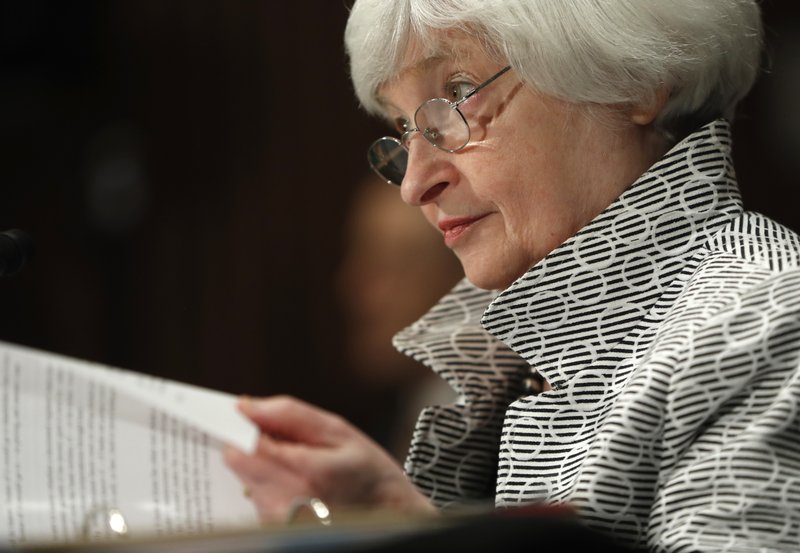WASHINGTON -- The Federal Reserve on Wednesday decided to keep its benchmark interest rate unchanged, but it signaled that it's edging closer to gradually shrinking its bond holdings, a move that will lead to higher long-term borrowing rates for mortgages and credit cards, economists say.
The central bank decided after ending its latest policy meeting to leave its key rate unchanged in a range of 1 percent to 1.25 percent after having raised rates twice this year in March and June.
The Fed says it still envisions further "gradual" rate increases. But many economists say they foresee no further rate increases this year unless inflation picks up.
Fed officials said inflation has stayed undesirably low even though the job market keeps strengthening, with the U.S. unemployment rate just 4.4 percent. Normally, solid job growth drives up wages and prices. But the Fed's preferred gauge of inflation has moved further below its 2 percent target in recent months.
With the U.S. job market still solid after eight years of a grinding but durable recovery, the Fed has essentially met one of its two mandates -- to maximize employment. But it has so far failed to achieve its other goal of stabilizing inflation at a favorable level.
Inflation has been edging further below the Fed's 2 percent target in recent months. The problem is that too-low inflation can slow the economy by causing consumers to delay purchases if they think they can buy a product or service for a lower price later.
Addressing its bond portfolio, the Fed slightly changed its statement to say such a reduction would begin "relatively soon," provided the economy improves further. Many economists think the Fed will begin shrinking its balance sheet sometime this fall.
The Fed's balance sheet has soared fivefold -- to $4.5 trillion -- since the summer of 2008, just before the financial crisis began. The balance sheet grew as a result of bond purchases by the Fed that were intended to lower long-term loan rates and stimulate a struggling economy.
Now, the reverse is expected: A sell-off of the bonds, even a gradual one, would likely make some long-term loans for consumers and businesses more expensive.
"The Fed is shifting their immediate focus away from short-term interest rates and toward beginning the normalization process of the $4.5 trillion balance sheet," said Greg McBride, chief financial analyst at Bankrate.com.
Under its exit plan, which it described in June, the Fed would gradually reduce its holdings -- initially at the slow pace of $10 billion a month.
McBride said this shift could represent a "reprieve for credit card holders and home equity borrowers," whose rates are more influenced by the Fed's benchmark rate.
Many economists say they think the Fed could announce after its September meeting a precise date for the start of the bond reductions. Some foresee the process beginning in October.
"A start date for the balance-sheet normalization is all teed up for the September meeting," McBride said.
Months ago, the Fed had signaled its readiness to raise rates three times this year on the assumption that it needed to be more aggressive to ensure that consistently low unemployment didn't contribute to high inflation later on.
But in testifying to Congress this month, Fed Chairman Janet Yellen had sounded less sure about her previous position that the slowdown in inflation this year was because of such temporary factors as a big drop in charges for cellphone plans.
Yellen conceded that Fed officials were puzzled by recent developments. Her remarks lifted financial markets as investors interpreted her words to suggest that the Fed might slow its pace of rate increases.
Over the past 12 months, the inflation gauge the Fed monitors most closely has risen just 1.4 percent, according to the latest data. That's down from a 1.9 percent year-over-year increase in January. Many economists say they think the Fed will put off any further rate increases until inflation resumes rising toward its 2 percent target.
After leaving its key rate at a record low near zero for seven years after the 2008 financial crisis, the Fed has raised it modestly four times -- in December 2015, December 2016 and twice so far this year, in March and June. Even now, the rate remains historically low and significantly below the 3 percent level that the Fed sees as "neutral." That's the point at which the Fed's benchmark rate neither stimulates nor slows economic activity.
Markets have largely shaken off the Fed's retreat. Borrowing costs remain low and loan terms have shown little sign of tightening.
"I expect an announcement of the onset of the balance-sheet reduction at the conclusion of the September meeting, effective on the first of October," Carl Tannenbaum, chief economist at Northern Trust Corp. in Chicago, said after Wednesday's statement.
In her recent congressional testimony, Yellen didn't rule out another rate increase this year. But investors have themselves grown more uncertain, with the CME Group's closely watched gauge foreseeing a 52 percent chance of another rate increase by year's end.
The Fed's statement Wednesday coincides with a period of lackluster growth for the U.S. economy. During the January-March quarter this year, the gross domestic product, the broadest gauge of economic health, grew at a 1.4 percent annual rate -- well below a healthy pace and far below the consistent 3 percent or more annual growth that President Donald Trump's administration has said it can achieve.
During the April-June quarter, the economy is generally thought to have grown at an annual rate of about 2.5 percent. The government will offer a preliminary estimate of that figure Friday.
Information for this article was contributed by Martin Crutsinger of The Associated Press, by Binyamin Appelbaum of The New York Times and by Craig Torres of Bloomberg News.
Business on 07/27/2017
